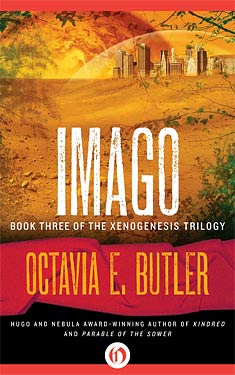Octavia
Butler
Completed 1/26/2019,
Reviewed 1/27/2019
4 stars
I learned two
new words for this book. Bildungsroman-a
novel dealing with one’s formative years or spiritual journey. I also had to look up Imago-the final adult
stage in the metamorphosis of an insect. This final book of the Xenogenesis series is a
bildungsroman of the first ooloi construct, that is, the first neuter gendered hybrid, or construct, of human and alien parents, as it metamorphosizes into an adult. It has the same themes as the first two
books, but is made much more personal, as this book is narrated in first person
by the ooloi. Once again, Butler shines
in the details of the personalities of the aliens. Her prose is stunning, not too flowery, not
too sparse, and her dialogue is very believable.
 Jodahs is
the child of Lilith and Tomas. Being a
juvenile construct, it has no sexual definition, but everything seems to point
to it being a male. Then Jodahs goes
into metamorphosis and everyone is surprised that it is going to be an ooloi. There weren’t supposed to be any ooloi
constructs, but Jodahs seems to have happened by accident. As an ooloi, it has great powers to heal
itself and others, and Jodahs burns with the desire to help others. Unfortunately, it also has the power to cause
disease and malformity. Ooloi go through
two metamorphoses, one to become a sub-adult, and one to become a full
adult. While a sub-adult, Jodahs is
dangerous. So he is exiled from the
community so as not to harm anyone. Its
family goes with it.
Jodahs is
the child of Lilith and Tomas. Being a
juvenile construct, it has no sexual definition, but everything seems to point
to it being a male. Then Jodahs goes
into metamorphosis and everyone is surprised that it is going to be an ooloi. There weren’t supposed to be any ooloi
constructs, but Jodahs seems to have happened by accident. As an ooloi, it has great powers to heal
itself and others, and Jodahs burns with the desire to help others. Unfortunately, it also has the power to cause
disease and malformity. Ooloi go through
two metamorphoses, one to become a sub-adult, and one to become a full
adult. While a sub-adult, Jodahs is
dangerous. So he is exiled from the
community so as not to harm anyone. Its
family goes with it.
In addition
to the desire to heal, Jodahs also has a burning desire to mate with
humans. This would be difficult because most
of the humans now on Earth have been forced-sterilized by the Oankali. The fertile ones are already in familial
relationships with Oankali. However, in
one of its lonely excursions from his family, Jodahs meets two humans who are
descendants of people who were never captured by the Oankali. Besides being fertile, they also have a debilitating
genetic condition causing spots and tumors to grow on the body. They are terrified of him, but he heals their
condition and quickly seduces them. As
in the previous two books, the remainder of this book deals with the desire to
bring all the remaining humans into the fold, to become parts of Oankali-human
hybrid families, or go to the new Martian colony to live life fertile and away
from the Oankali.
There is
another definition for imago-an unconscious idealized mental image of someone. There is also Imago therapy-a form of marriage
therapy that takes a relationship approach rather than an individualistic
one. This latter definition became
prominent in the late 80’s, and Butler probably didn’t know about it. However, it is interesting because Jodahs’
main conflict is a relational one. It
craves a relationship with humans and solves their problems by being in relationship
with them. I don’t know if this is a
stretch, but the connections really clicked in my head.
It’s kind of
hard to review this book because I feel like I’ve already reviewed it via the
first two books. What sets this book apart,
though is the POV. Jodahs is the most
human-oriented construct so far and can teach the Oankali a lot about the
humans. It being first person
perspective makes it real and immediate.
However, it is indicative of the final wiping out of the human race by
mating with the last of the fertile humans, creating a new hybrid species. But this presents the one plot hole I think I’ve
found in the book. If ooloi constructs
are driven to mate with full humans, what happens to these ooloi when the last
of the humans run out? Can they mate
with male and female constructs? This
question is never raised, but it was in the back of my mind through the whole
book.
I give this
book and this series four out of five stars.
It’s probably one of the most interesting and innovative alien invasion stories
I’ve ever read.
No comments:
Post a Comment